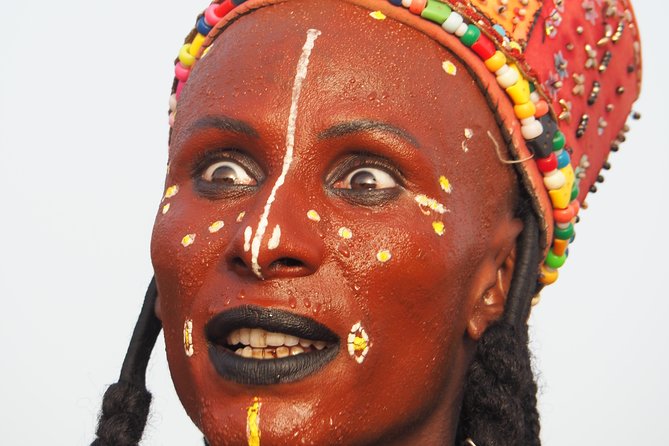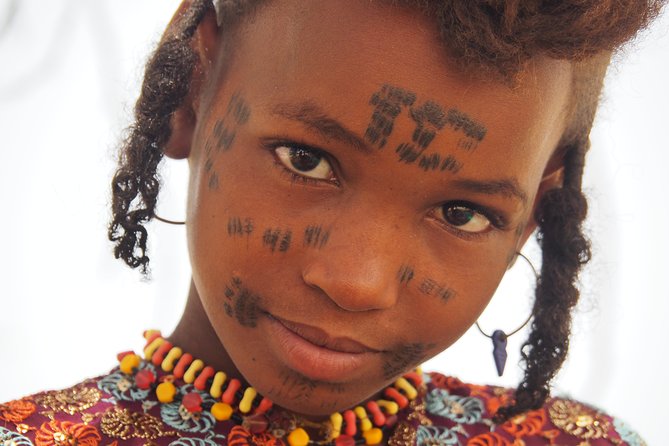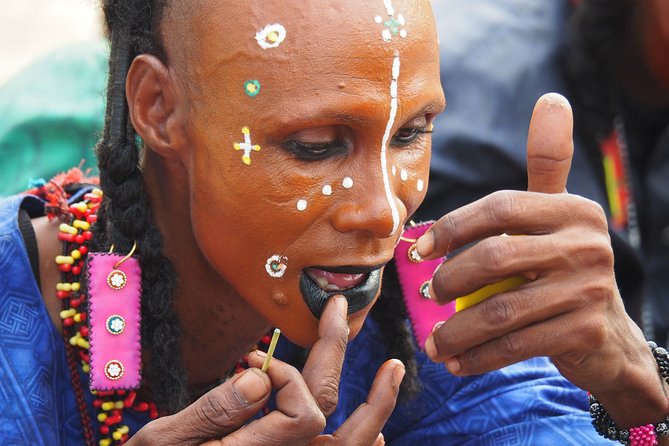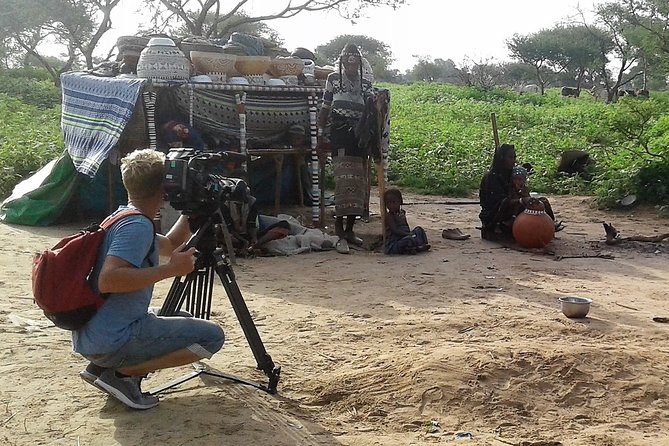ETNIE – Traditional Gerewol Dances immerses audiences in the cultural tapestry of the Wodaabe people, offering a glimpse into their vibrant traditions and unique customs. As the rhythmic beats fill the air and dancers move with precision and grace, spectators are transported to a world where storytelling unfolds through dance. The intricate details of the traditional attire and the symbolic gestures woven into each movement leave observers captivated, eager to uncover the deeper meanings behind this mesmerizing display of heritage and artistry.
Good To Know

- Gerewol Dances are deeply rooted in Wodaabe tribal customs.
- They are integral to celebrating the end of the rainy season.
- Young Wodaabe men use the dances for courtship rituals.
- The dances showcase vibrant traditions and cultural connections.
- Attire during Gerewol Dances symbolizes beauty, elegance, and cultural significance.
Cultural Significance
The Traditional Gerewol Dances hold immense cultural significance among the local tribes in Chad, showcasing vibrant traditions and social connections.
These dances aren’t merely performances but serve as a way for the tribes to express their cultural identity, values, and history.
Through intricate movements, colorful attire, and rhythmic music, the Gerewol Dances symbolize unity, celebration, and the passing down of ancestral heritage.
Participants, adorned in elaborate costumes and body paint, engage in these dances as a form of storytelling and community bonding.
The dances also play a crucial role in preserving and transmitting cultural knowledge from one generation to the next, ensuring that the rich traditions of the tribes in Chad endure through time.
Find more activities and experiences we've covered in NDjamena.
Gerewol Dance Origins

Originating from centuries-old tribal customs, Gerewol Dances trace their roots back to the rich cultural tapestry of the indigenous communities in Chad. The origins of this vibrant dance form are deeply intertwined with the history and traditions of the Wodaabe people, showcasing a blend of storytelling, celebration, and courtship rituals.
Gerewol Dances are believed to have originated as a way to celebrate the end of the rainy season.
The dances serve as a platform for young Wodaabe men to showcase their attractiveness and woo potential partners.
Each movement in the dance has symbolic significance, reflecting aspects of Wodaabe culture and beliefs.
The intricate facial paintings and elaborate costumes worn during Gerewol performances have been passed down through generations, preserving the authenticity of this cultural practice.
Traditional Attire

Celebrated for its vibrant colors and intricate designs, the traditional attire worn during Gerewol Dances embodies the essence of Wodaabe culture. The attire is a crucial aspect of the dance performance, symbolizing beauty, elegance, and cultural significance. Men and women wear distinct garments that reflect their roles and traditions within the Wodaabe community. Below is a table showcasing the key elements of the traditional attire worn during Gerewol Dances:
| Attire Element | Description | Significance |
|---|---|---|
| Grand Boubou | Flowing robe with embroidery | Symbolizes status and wealth |
| Kaftan | Colorful, loose-fitting tunic | Represents beauty and grace |
| Beaded Jewelry | Elaborate necklaces and bracelets | Adds a touch of glamour and tradition |
Dance Performances
Amidst the festive ambiance of the Wodaabe cultural gathering, vibrant movements and rhythmic beats intertwine to create captivating dance performances during the Gerewol festivities. The dance performances are a sight to behold, showcasing the agility and grace of the dancers as they move in harmony with the traditional music.
Here are some aspects that make these performances truly mesmerizing:
- Elaborate body paint designs that enhance the visual appeal of the dancers.
- Intricate footwork that adds a layer of complexity and skill to the performances.
- Expressive facial expressions that convey emotions and tell stories through the dance.
- Dynamic group formations that create a sense of unity and coordination among the dancers.
Music and Instruments

The traditional Gerewol dances are accompanied by vibrant music played on a variety of indigenous instruments. These instruments include the molo, a string instrument similar to a guitar, and the kalangu, a type of drum that sets the rhythm for the dancers.
The Fulani people use these instruments to create energetic and rhythmic melodies that resonate throughout the dancing grounds, setting the tone for the performances. The music is a crucial element of the Gerewol dances, enhancing the overall experience for both the dancers and the spectators.
The combination of the lively music and the graceful movements of the dancers creates a mesmerizing atmosphere that captivates all who witness this traditional celebration.
Audience Participation
As the traditional Gerewol dances unfold, audience participation becomes an integral part of the lively and immersive experience. Spectators aren’t merely observers but are encouraged to engage actively in the celebration through various ways:
Clapping and Cheering: The energetic beats of the drums and the mesmerizing dances often prompt spontaneous clapping and cheering from the audience.
Joining the Dance: In some instances, audience members are invited to join the dancers, adding an extra layer of excitement to the event.
Traditional Chants: Visitors can learn and participate in traditional chants that accompany the dance performances, enhancing the cultural exchange.
Celebratory Gestures: Mimicking the celebratory gestures of the performers can create a sense of unity and shared experience among the audience.
Festive Atmosphere

Engaging in the vibrant Gerewol dances creates an electrifying and joyous festive atmosphere that captivates participants with its cultural richness and communal spirit.
The rhythmic beats of the drums, the mesmerizing movements of the dancers, and the colorful traditional attire all contribute to the lively ambiance.
As the dancers showcase their skills and grace, the onlookers are enveloped in a sense of celebration and unity. Laughter and cheers fill the air, and a sense of togetherness prevails among the crowd.
The festive atmosphere of the Gerewol dances not only entertains but also educates, offering a glimpse into the traditions and values of the Wodaabe people.
It’s an experience that leaves a lasting impression on all who partake in the festivities.
Regional Variations
Immersing oneself in the diverse regional variations of Gerewol dances reveals a tapestry of cultural expressions and traditions. Each region puts its unique spin on the dance, showcasing the rich diversity within the Gerewol tradition.
Colorful Costumes: Different regions exhibit distinct costume styles, from vibrant fabrics to intricate beadwork.
Musical Influences: Regional variations include diverse musical instruments and rhythms, adding depth to the performances.
Choreography Styles: Each region may have its signature dance moves and formations, reflecting local customs and beliefs.
Narrative Themes: The storytelling aspects of Gerewol dances can vary, with regions emphasizing different themes such as love, nature, or historical events.
Frequently Asked Questions
Can Children Participate in Gerewol Dances?
Children can participate in gerewol dances, showcasing their cultural appreciation and involvement. It’s a fantastic opportunity for them to immerse in tradition and celebrations. Embracing diverse experiences fosters understanding and enriches their cultural awareness.
Are Photos Allowed During the Dance Performances?
Photos are allowed during the dance performances. Capturing these vibrant cultural moments can enhance the experience. However, it’s important to be respectful and mindful of the performers and other spectators while taking pictures.
Is There a Specific Age Group for Gerewol Dancers?
Age groups for Gerewol dancers vary, typically ranging from late teens to early adulthood. Young men participate in these traditional dances to showcase their beauty and attract potential partners. It’s a significant cultural event.
How Long Do Gerewol Dance Performances Typically Last?
Traditional Gerewol dance performances typically last around 6-8 hours, showcasing vibrant costumes, intricate movements, and rhythmic music. These events immerse spectators in the rich culture and traditions of the Wodaabe people, creating a captivating experience.
Are There Any Restrictions on Audience Participation in the Dances?
Audience participation in the dances is encouraged, adding to the vibrant atmosphere. However, spectators should respect cultural norms and traditions. Joining in with enthusiasm and respect enhances the overall experience for everyone involved.
The Sum Up
Experience the mesmerizing beauty and cultural richness of ETNIE – Traditional Gerewol Dances.
From the vibrant dances to the elaborate traditional attire and rhythmic music, this performance showcases the deep-rooted traditions and heritage of the Wodaabe people in Chad.
Through expressive movements and colorful body paint designs, ETNIE celebrates unity, celebration, and ancestral connections, creating a truly captivating experience that will leave you in awe of this unique cultural art form.
